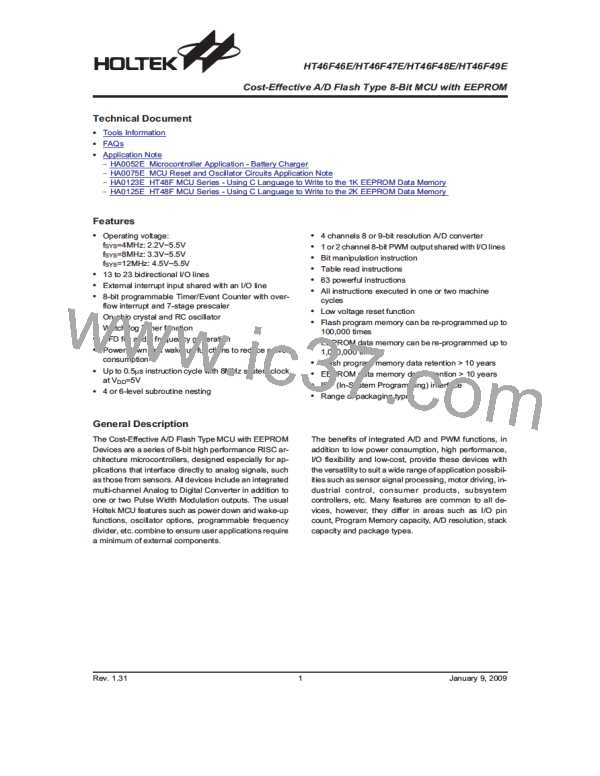HT46F46E/HT46F47E/HT46F48E/HT46F49E
Program Counter
met, the next instruction, which has already been
fetched during the present instruction execution, is dis-
During program execution, the Program Counter is used
to keep track of the address of the next instruction to be
executed. It is automatically incremented by one each
time an instruction is executed except for instructions,
such as ²JMP² or ²CALL² that demand a jump to a
non-consecutive Program Memory address. For the
Cost-Effective A/D Flash Type with EEPROM series of
microcontrollers, note that the Program Counter width
varies with the Program Memory capacity depending
upon which device is selected. However, it must be
noted that only the lower 8 bits, known as the Program
Counter Low Register, are directly addressable by user.
carded and a dummy cycle takes its place while the cor-
rect instruction is obtained.
The lower byte of the Program Counter, known as the
Program Counter Low register or PCL, is available for
program control and is a readable and writable register.
By transferring data directly into this register, a short
program jump can be executed directly, however, as
only this low byte is available for manipulation, the
jumps are limited to the present page of memory, that is
256 locations. When such program jumps are executed
it should also be noted that a dummy cycle will be in-
serted.
When executing instructions requiring jumps to
non-consecutive addresses such as a jump instruction,
a subroutine call, interrupt or reset, etc., the
microcontroller manages program control by loading the
required address into the Program Counter. For condi-
tional skip instructions, once the condition has been
The lower byte of the Program Counter is fully accessi-
ble under program control. Manipulating the PCL might
cause program branching, so an extra cycle is needed
to pre-fetch. Further information on the PCL register can
be found in the Special Function Register section.
Program Counter Bits
Mode
b11
0
b10
0
b9
0
b8
0
b7
0
b6
0
b5
0
b4
0
b3
0
b2
0
b1
0
b0
0
Initial Reset
External Interrupt
0
0
0
0
0
0
0
0
0
1
0
0
Timer/Event Counter
Overflow
0
0
0
0
0
0
0
0
0
0
0
0
0
0
0
0
1
1
0
1
0
0
0
0
A/D Converter Interrupt
Skip
Program Counter + 2
Loading PCL
PC11 PC10 PC9 PC8 @7
@6
#6
@5
#5
@4
#4
@3
#3
@2
#2
@1
#1
@0
#0
Jump, Call Branch
Return from Subroutine
#11
#10
#9
S9
#8
S8
#7
S7
S11 S10
S6
S5
S4
S3
S2
S1
S0
Program Counter
Note: PC11~PC8: Current Program Counter bits
@7~@0: PCL bits
#11~#0: Instruction code address bits
S11~S0: Stack register bits
For the HT46F49E, the Program Counter is 12 bits wide, i.e. from b11~b0.
For the HT46F47E and HT46F48E, the Program Counter is 11 bits wide, i.e. From
b10~b0, therefore the b11 column in the table is not applicable.
For the HT46F46E, the Program Counter is 10 bits wide, i.e. from b9~b0, therefore the b11 and
b10 the columns in the table are not applicable.
Rev. 1.31
10
January 9, 2009

 HOLTEK [ HOLTEK SEMICONDUCTOR INC ]
HOLTEK [ HOLTEK SEMICONDUCTOR INC ]